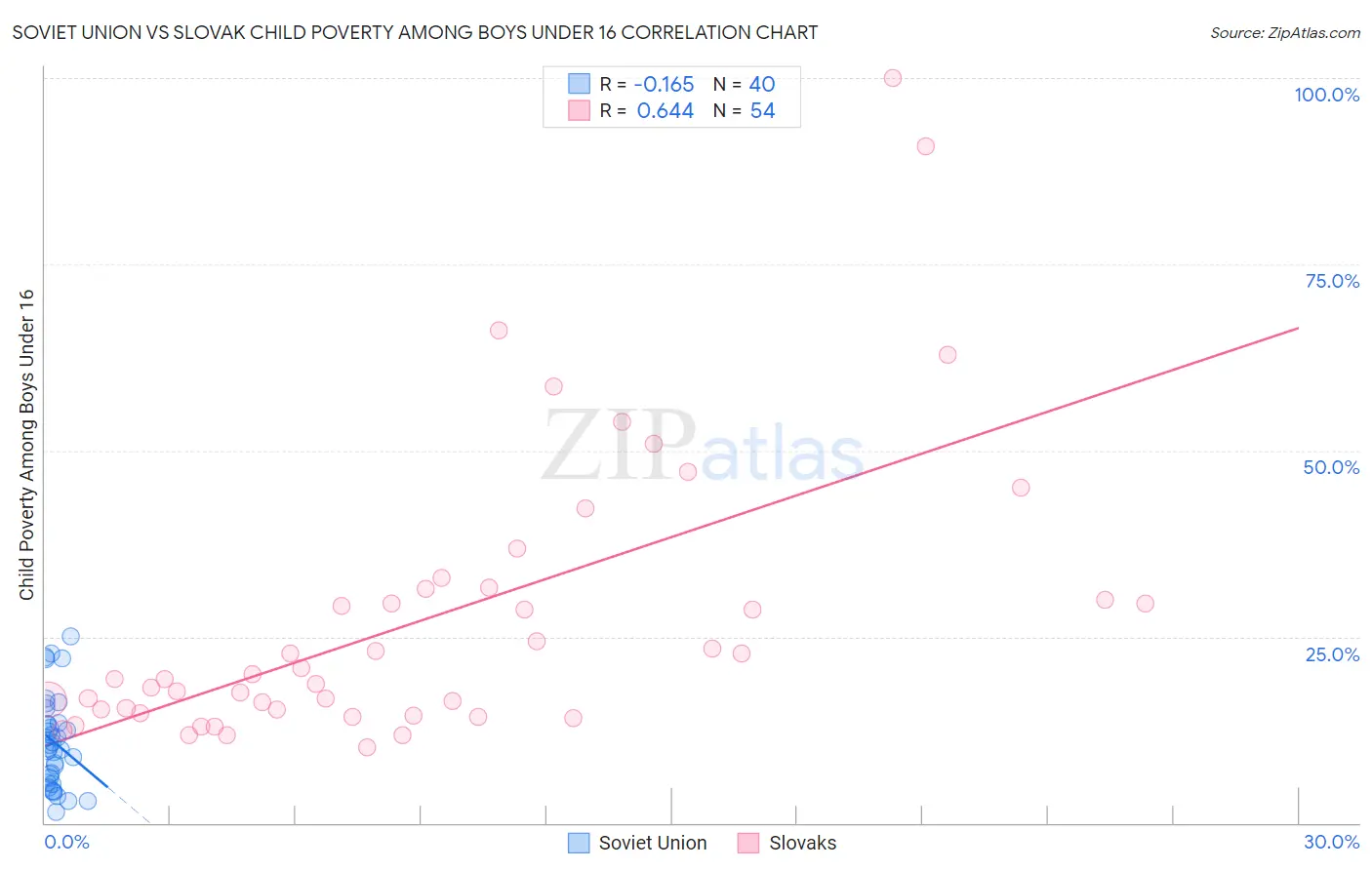Soviet Union vs Slovak Child Poverty Among Boys Under 16
COMPARE
Soviet Union
Slovak
Child Poverty Among Boys Under 16
Child Poverty Among Boys Under 16 Comparison
Soviet Union
Slovaks
14.5%
CHILD POVERTY AMONG BOYS UNDER 16
98.5/ 100
METRIC RATING
65th/ 347
METRIC RANK
15.8%
CHILD POVERTY AMONG BOYS UNDER 16
80.3/ 100
METRIC RATING
149th/ 347
METRIC RANK
Soviet Union vs Slovak Child Poverty Among Boys Under 16 Correlation Chart
The statistical analysis conducted on geographies consisting of 43,374,507 people shows a poor negative correlation between the proportion of Soviet Union and poverty level among boys under the age of 16 in the United States with a correlation coefficient (R) of -0.165 and weighted average of 14.5%. Similarly, the statistical analysis conducted on geographies consisting of 388,579,865 people shows a significant positive correlation between the proportion of Slovaks and poverty level among boys under the age of 16 in the United States with a correlation coefficient (R) of 0.644 and weighted average of 15.8%, a difference of 8.7%.

Child Poverty Among Boys Under 16 Correlation Summary
| Measurement | Soviet Union | Slovak |
| Minimum | 1.4% | 10.2% |
| Maximum | 25.1% | 100.0% |
| Range | 23.7% | 89.8% |
| Mean | 10.8% | 27.6% |
| Median | 10.3% | 19.6% |
| Interquartile 25% (IQ1) | 5.8% | 15.2% |
| Interquartile 75% (IQ3) | 13.4% | 31.5% |
| Interquartile Range (IQR) | 7.6% | 16.3% |
| Standard Deviation (Sample) | 6.1% | 19.3% |
| Standard Deviation (Population) | 6.0% | 19.2% |
Similar Demographics by Child Poverty Among Boys Under 16
Demographics Similar to Soviet Union by Child Poverty Among Boys Under 16
In terms of child poverty among boys under 16, the demographic groups most similar to Soviet Union are Immigrants from Bulgaria (14.5%, a difference of 0.010%), Immigrants from Romania (14.5%, a difference of 0.030%), Immigrants from Europe (14.5%, a difference of 0.030%), Slovene (14.5%, a difference of 0.12%), and Cambodian (14.5%, a difference of 0.16%).
| Demographics | Rating | Rank | Child Poverty Among Boys Under 16 |
| Immigrants | Sweden | 98.9 /100 | #58 | Exceptional 14.4% |
| Immigrants | Czechoslovakia | 98.9 /100 | #59 | Exceptional 14.4% |
| Immigrants | Belgium | 98.9 /100 | #60 | Exceptional 14.4% |
| Scandinavians | 98.8 /100 | #61 | Exceptional 14.4% |
| Immigrants | Israel | 98.7 /100 | #62 | Exceptional 14.4% |
| Cambodians | 98.5 /100 | #63 | Exceptional 14.5% |
| Immigrants | Romania | 98.5 /100 | #64 | Exceptional 14.5% |
| Soviet Union | 98.5 /100 | #65 | Exceptional 14.5% |
| Immigrants | Bulgaria | 98.5 /100 | #66 | Exceptional 14.5% |
| Immigrants | Europe | 98.4 /100 | #67 | Exceptional 14.5% |
| Slovenes | 98.4 /100 | #68 | Exceptional 14.5% |
| Immigrants | Austria | 98.4 /100 | #69 | Exceptional 14.5% |
| Europeans | 98.4 /100 | #70 | Exceptional 14.5% |
| Immigrants | Netherlands | 98.1 /100 | #71 | Exceptional 14.6% |
| Immigrants | Latvia | 98.1 /100 | #72 | Exceptional 14.6% |
Demographics Similar to Slovaks by Child Poverty Among Boys Under 16
In terms of child poverty among boys under 16, the demographic groups most similar to Slovaks are Immigrants from Jordan (15.8%, a difference of 0.010%), Puget Sound Salish (15.8%, a difference of 0.090%), Brazilian (15.8%, a difference of 0.14%), Immigrants from Venezuela (15.8%, a difference of 0.14%), and French (15.8%, a difference of 0.28%).
| Demographics | Rating | Rank | Child Poverty Among Boys Under 16 |
| Immigrants | Hungary | 84.1 /100 | #142 | Excellent 15.7% |
| Immigrants | Fiji | 83.6 /100 | #143 | Excellent 15.7% |
| Immigrants | Peru | 83.5 /100 | #144 | Excellent 15.7% |
| Samoans | 83.2 /100 | #145 | Excellent 15.7% |
| New Zealanders | 82.4 /100 | #146 | Excellent 15.7% |
| Venezuelans | 82.1 /100 | #147 | Excellent 15.7% |
| Brazilians | 81.0 /100 | #148 | Excellent 15.8% |
| Slovaks | 80.3 /100 | #149 | Excellent 15.8% |
| Immigrants | Jordan | 80.2 /100 | #150 | Excellent 15.8% |
| Puget Sound Salish | 79.8 /100 | #151 | Good 15.8% |
| Immigrants | Venezuela | 79.5 /100 | #152 | Good 15.8% |
| French | 78.7 /100 | #153 | Good 15.8% |
| Syrians | 77.5 /100 | #154 | Good 15.9% |
| French Canadians | 76.6 /100 | #155 | Good 15.9% |
| Israelis | 76.5 /100 | #156 | Good 15.9% |